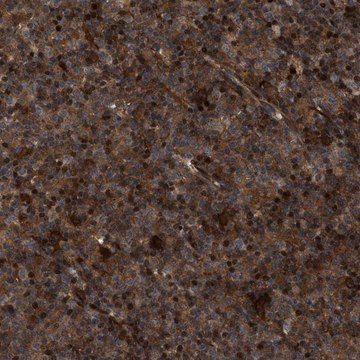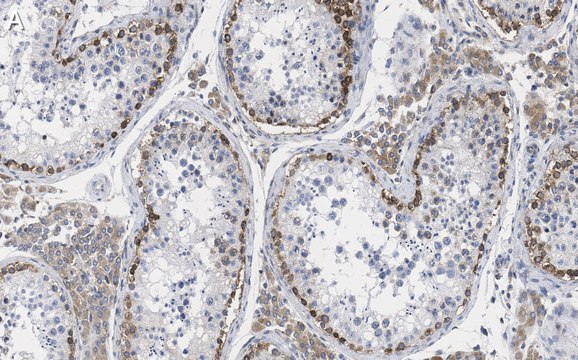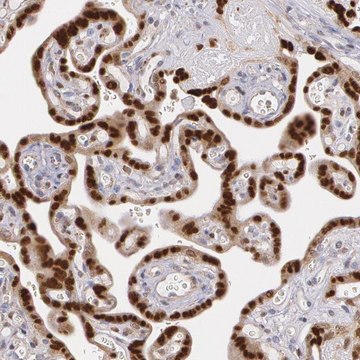AB5052
Anti-Glycine Receptor Antibody
Chemicon®, from rabbit
Sign Into View Organizational & Contract Pricing
All Photos(4)
About This Item
UNSPSC Code:
12352203
eCl@ss:
32160702
NACRES:
NA.41
Recommended Products
biological source
rabbit
Quality Level
antibody form
affinity purified immunoglobulin
antibody product type
primary antibodies
clone
polyclonal
purified by
affinity chromatography
species reactivity
rat, mouse, human
manufacturer/tradename
Chemicon®
technique(s)
immunoprecipitation (IP): suitable
western blot: suitable
NCBI accession no.
UniProt accession no.
shipped in
dry ice
target post-translational modification
unmodified
Gene Information
human ... GLRB(2743)
Specificity
Recognizes glycine receptor alpha1. Shows cross reactivity to glycine receptor alpha2. subunits The antibody has been used successfully in Western blot and immunoprecipitation assays with cell extracts containing recombinant human glycine receptors and with homogenates of mouse spinal cord. By Western blot the antibody recognizes a protein with a molecular weight of ~ 48 kD.
Immunogen
Peptide from the amino terminus of the human alpha1 glycine receptor subunit conjugated to KLH.
Application
Anti-Glycine Receptor Antibody detects level of Glycine Receptor & has been published & validated for use in IP & WB.
Research Category
Neuroscience
Neuroscience
Research Sub Category
Ion Channels & Transporters
Ion Channels & Transporters
Western blot: 1:1000 using ECL
Immunoprecipitation: 1:10 following the protocol of Raymond et al., Nature (1993) 361:637-641.
Optimal working dilutions must be determined by the end user.
Immunoprecipitation: 1:10 following the protocol of Raymond et al., Nature (1993) 361:637-641.
Optimal working dilutions must be determined by the end user.
Physical form
Affinity purified immunoglobulin. Lyophilized from ammonium bicarbonate (5mM) some residual salt may be present. Reconstitute with 100 μL of PBS. Contains no preservatives.
Storage and Stability
Maintain lyophilized material at -20°C for up to 12 months after date of receipt. After reconstitution maintain at -20°C in undiluted aliquots for up to 6 months. Avoid repeated freeze/thaw cycles.
Legal Information
CHEMICON is a registered trademark of Merck KGaA, Darmstadt, Germany
Disclaimer
Unless otherwise stated in our catalog or other company documentation accompanying the product(s), our products are intended for research use only and are not to be used for any other purpose, which includes but is not limited to, unauthorized commercial uses, in vitro diagnostic uses, ex vivo or in vivo therapeutic uses or any type of consumption or application to humans or animals.
Not finding the right product?
Try our Product Selector Tool.
Storage Class Code
11 - Combustible Solids
WGK
WGK 1
Certificates of Analysis (COA)
Search for Certificates of Analysis (COA) by entering the products Lot/Batch Number. Lot and Batch Numbers can be found on a product’s label following the words ‘Lot’ or ‘Batch’.
Already Own This Product?
Find documentation for the products that you have recently purchased in the Document Library.
Differential plasticity of the GABAergic and glycinergic synaptic transmission to rat lumbar motoneurons after spinal cord injury.
Sadlaoud, K; Tazerart, S; Brocard, C; Jean-Xavier, C; Portalier, P; Brocard, F; Vinay, L; Bras, H
The Journal of Neuroscience null
K Baer et al.
Neuroscience, 122(3), 773-784 (2003-11-19)
Gephyrin is a postsynaptic clustering molecule that forms a protein scaffold to anchor inhibitory neurotransmitter receptors at the postsynaptic membrane of neurons. Gephyrin was first identified as a protein component of the glycine receptor complex and is also colocalized with
Localization of glycine receptors in the human forebrain, brainstem, and cervical spinal cord: an immunohistochemical review.
Baer K, Waldvogel HJ, Faull RL, Rees MI
Frontiers in Molecular Neuroscience null
Decreases of glycine receptor expression induced by median nerve injury in the rat cuneate nucleus contribute to NPY release and c-Fos expression.
Seu-Hwa Chen,Yi-Ju Tsai,Hsin-Ying Wang,Chi-Te Lin,Shin-Fang Li,June-Horng Lue
Life Sciences null
Y Y Liu et al.
Journal of applied physiology (Bethesda, Md. : 1985), 91(3), 1387-1395 (2001-08-18)
The pre-Bötzinger complex (PBC), thought to be the center of respiratory rhythm generation, is a cell column ventrolateral to the nucleus ambiguus. The present study analyzed its cellular and neurochemical composition in adult rats. PBC neurons were mainly oval, fusiform
Our team of scientists has experience in all areas of research including Life Science, Material Science, Chemical Synthesis, Chromatography, Analytical and many others.
Contact Technical Service








